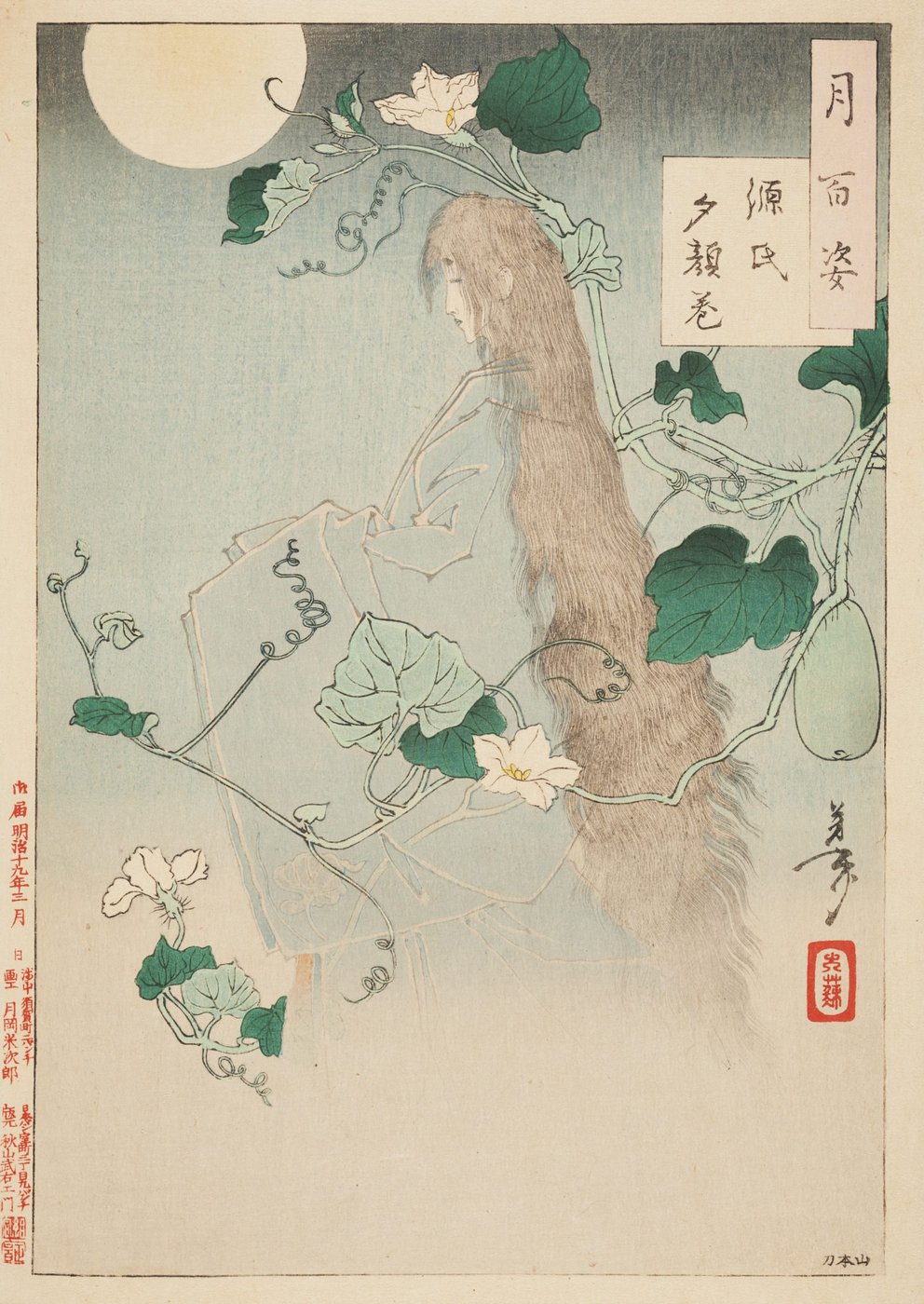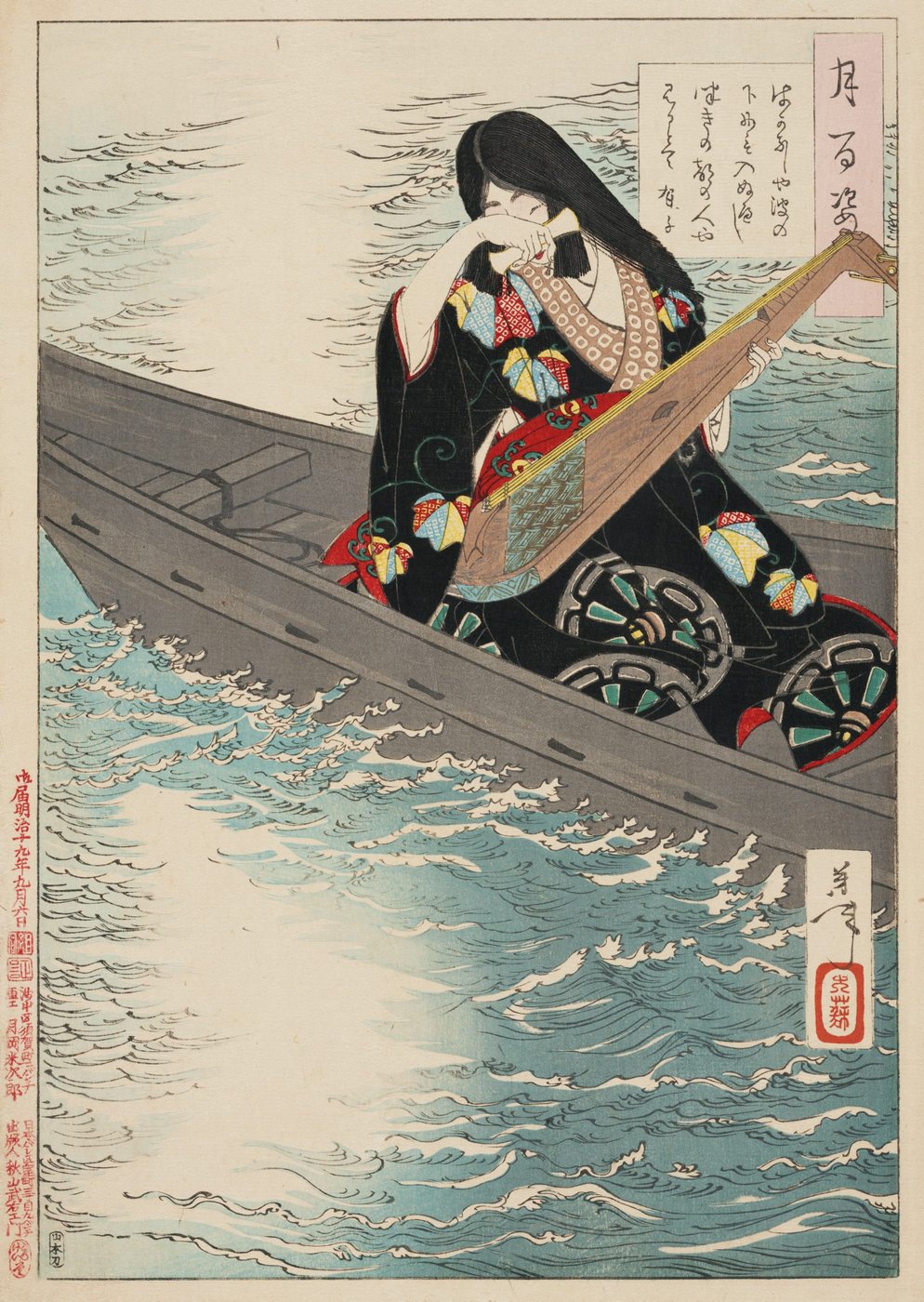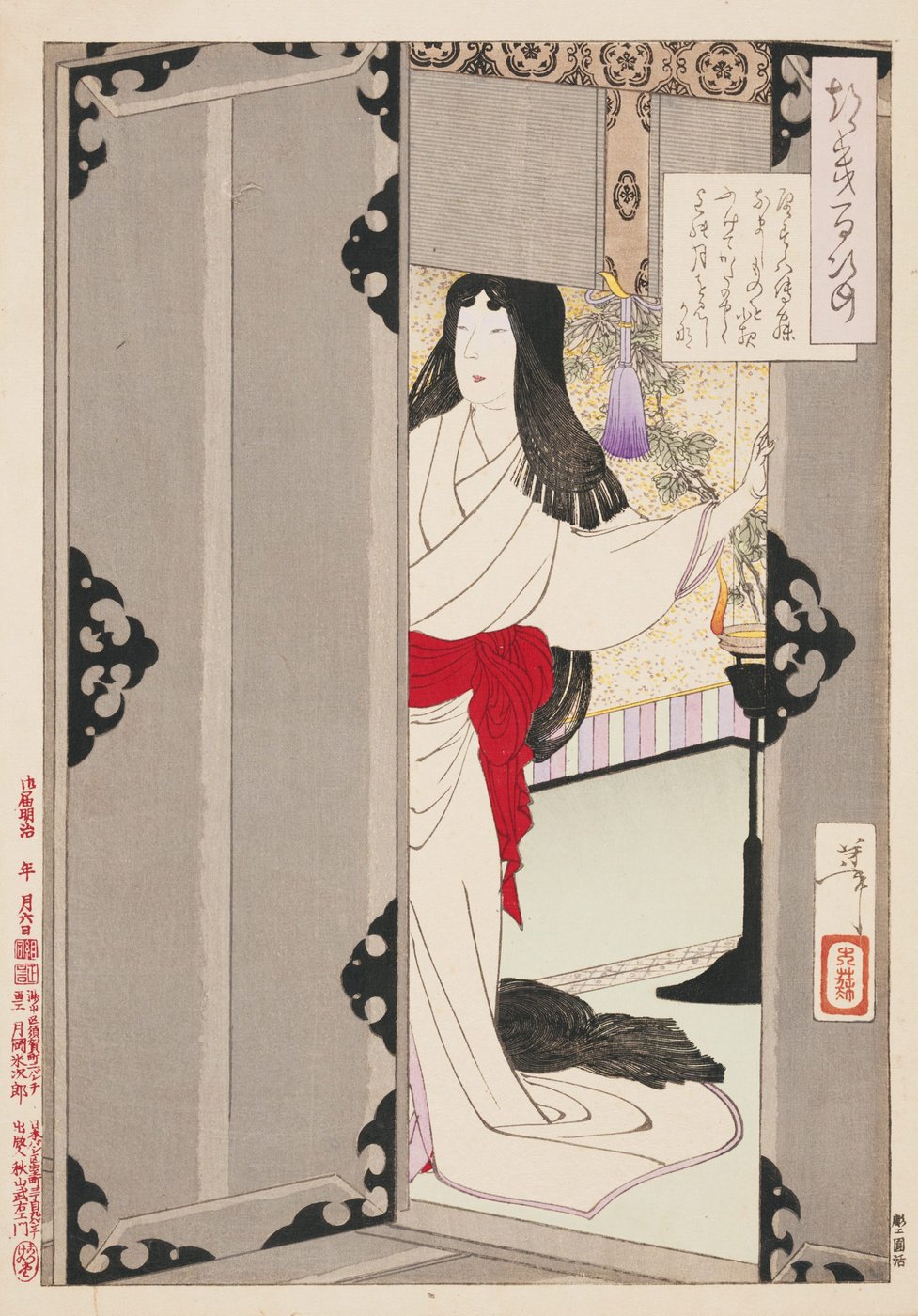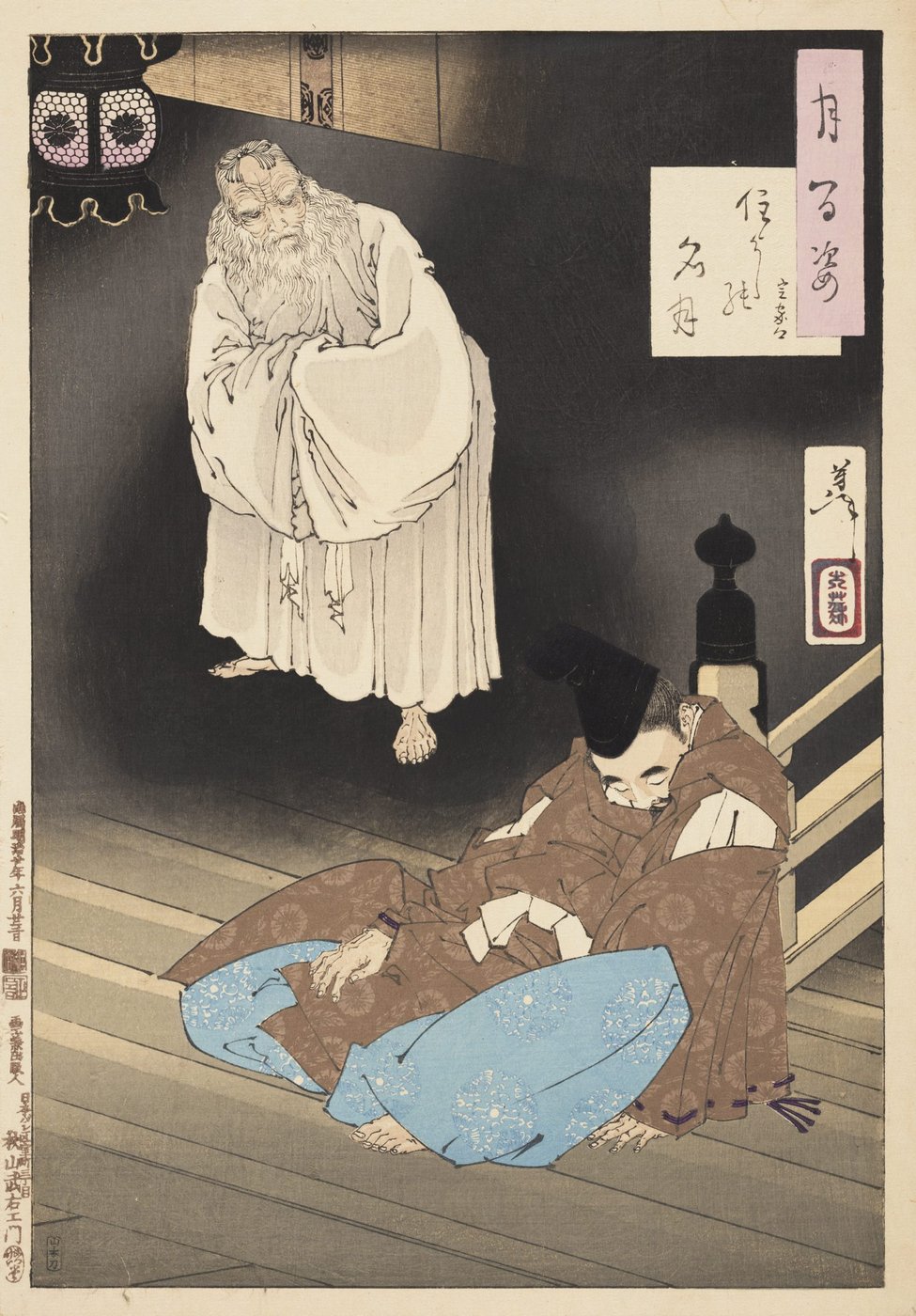Menu
Yoshitoshi
One hundred aspects of the moon 20 Aug – 20 Nov 2016
Aristocracy and the elite

I listen to the sound of the cloth being pounded/as the moon shines serenely/and believe that there is someone else/who has not yet gone to sleep - Tsunenobu, January 1886
Minamoto no Tsunenobu was active in the 11th century as an official at the Heian court. He also excelled in poetry and playing the Japanese short-necked lute (biwa). One night, as he enjoyed the autumn moon, he heard the sound of a mallet pounding cloth. This inspired him to recite the poem in the title, composed by Ki no Tsurayuki, one of the Thirty-six Immortal Poets. As he finished his recitation, a giant monster – whose hairy leg occupies the upper half of the design – appeared and recited a couplet by the famous eighth-century Chinese poet Li Bai in response: ‘In the northern sky geese fly across the Big Dipper/to the south cold robes are pounded under the moonlight.’
Enlarge
Mount Yoshino midnight-moon - Iga no Tsubone, January 1886
The winged god in this design is Sasaki no Kiyotaka, a high official at the court of Emperor Go-Daigo in the 14th century. Forced to commit ritual suicide for ill-advising the emperor, Kiyotaka’s restless spirit returned to haunt the court in exile of Yoshino Mountain. No courtier dared to face the angry ghost, except for the determined court lady Iga no Tsubone. Kiyotaka’s blue lips follow the convention used for corpses.
Enlarge
The moon glimmers like bright snow/and plum blossoms appear like reflected stars/ah! the golden mirror of the moon passes overhead/as fragrance from the jade chamber fills the garden - Sugawara no Michizane, January 1886
Sugawara no Michizane was a high official in the Heian court of the late ninth century. He was a brilliant scholar of Chinese literature and one of the finest poets who wrote in Chinese. Enemies blamed him for an eclipse of the Sun and forced him into exile and death in Kyushu, but his vengeful spirit was believed to have caused the deaths of his enemies and, subsequently, the emperor. Michizane was eventually pardoned and deified as Tenjin, the Shinto god of music, literature and calligraphy. He is also associated with harmonising Shinto with Zen Buddhism. It is unusual that Michizane is depicted here as a boy rather than as an influential adult.
Enlarge
Suzaku Gate moon - Hakuga Sammi, February 1886
The tenth-century courtier Minamoto no Hiromasa (also known as Hakuga Sanmi) was a famous musician who excelled in the biwa (short-necked lute), yokobue (horizontal flute) and hichiriki (flute played to the front). Here, he is playing the yokobue in a duet with an unidentified man whose heavy beard and unusual hat indicate that he is a foreigner, perhaps from central Asia. They are playing beneath the Suzaku Gate, the main gate to the area containing the imperial palace and government offices in Kyoto.
Enlarge
The Yūgao chapter from 'The tale of Genji', March 1886
This print represents Genji’s mysterious lover Yūgao, named after the evening glory flowers (yūgao) in her garden. She eventually accepted Genji’s invitation to visit one of his villas, but within a few hours of making love she died, killed by the jealous spirit of one of Genji’s former mistresses. Here, her blue-lipped ghost wafts through her garden among the yūgao vines.
Enlarge
Kitayama moon - Toyohara Sumiaki, June 1886
Toyohara Sumiaki was a music instructor and the epitome of an accomplished gentleman in the court of Emperor Go-Kashiwabara (reigned 1500–25). Drawn out to the moors north of the palace by the moon, he faces a pack of wolves. Assuming he was about to die, he played his favourite tune on his flute. To his amazement, the music pacified the wolves and they returned to the woods.
Enlarge
How hopeless it is/it would be better for me to sink beneath the waves/perhaps then I could see my man from Moon Capital - Ariko, September 1886
The woman depicted is Ariko no Naishi, a lady-in-waiting at the Heian court, who is about to commit suicide because of her unrequited love for Senior Councillor Tokudaiji no Sanesada. Her story was made into the nō play Ariko no Naishi. ‘Moon Capital’, mentioned in the title of the poem that Naishi recited before jumping from the boat, was a poetic name for Kyoto, the imperial capital.
Enlarge
I wish I had gone to bed immediately/but now the night has passed/and I watch the moon descend', c1887
This print illustrates the poem in the title cartouche by the Heian court lady and famous poetess Akazome Emon (956–1041). It expresses the feeling of a woman who has lost a night’s sleep waiting for her lover, who did not come. Emon served one of the emperor’s consorts and later joined the household of the most powerful political leader of the time, Fujiwara no Michinaga. Besides writing poetry, Emon was also known as the main author of the Eiga monogatari, a history of the Fujiwara family.
Enlarge
In the midst of glimmering whiteness/among the night's moon-shadows/I part the snow and pluck plum blossoms - Kintō, January 1887
Fujiwara no Kintō was a noted 11th-century musician, poet and historian at the Heian court. In this scene, Kintō is out in the palace garden on a winter night. Snow has just fallen on the blossoming plum branches. The serenity of the scene inspired Kintō to compose the poem cited in the title cartouche. Although not visible, the presence of the moon is hinted at in the poem.
Enlarge
Lady Gosechi, June 1887
Two noblemen in Heian court costumes are listening to the haunting sound of the koto (zither), played by a nun. The music, but also the desolate state of the lady’s dwelling, moved them to tears. ‘Gosechi’ literally means the five annual festivals celebrated at the imperial palace, but was also used to indicate the five beats in music. The lady’s name, therefore, alludes to the music and ritual of a glorious bygone age, when she was a young and beautiful court lady.
Enlarge
Sumiyoshi full moon - Lord Teika, June 1887
Fujiwara Teika, the celebrated 13th-century poet, fell asleep on the veranda of the Shinto shrine in Sumiyoshi. The god of poetry, to whom the shrine is dedicated, appeared to the poet in his dreams in the ghostlike form of an old man. Floating above Teika, the deity in his white robes appears to take the place of the full moon, which is missing here.
Enlarge
Does the cuckoo also/announce its name from above the clouds?/Yorimasa extemporises:/I only bent my bow/and the arrow shot itself, March 1888
The courtier depicted here is Minamoto no Yorimasa, an acclaimed poet and heroic warrior of the 12th century. His best-known exploit is the killing of the mystic beast nue, a composite creature that has the face of a monkey, the body of a badger, a tiger’s paws and tail, and a snake’s head at the end. The nue disturbed the emperor’s sleep with its shrieks and Yorimasa succeeded in shooting it down with a single arrow. The incident is included in the epic The tales of Heike and dramatised in the nō play Nue. The moon is not included in the design, but the shape of Yorimasa’s bow and his gaze upwards hint at a crescent moon.
Enlarge
